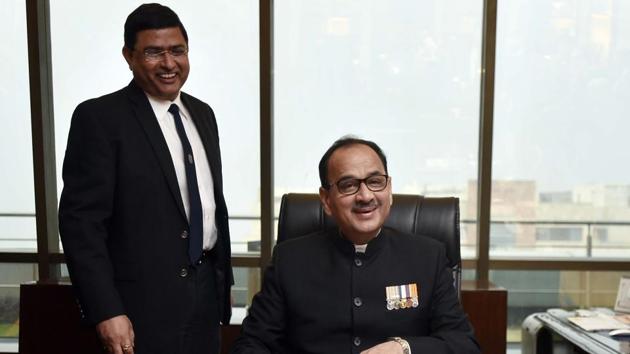The Gujarat model is under strain
Its centralising tendencies might have worked in a small state but now finds itself under strain when sought to be replicated at the Centre where the diverse nature of work and sheer scale of the government machine militates against any obsessively ‘controlling’ mindset
In the 70mm cacophonic build up to the 2014 general elections, a recurring theme was the hype around the so-called ‘Gujarat model’. The Bharatiya Janata Party’s (BJP) narrative through the campaign was that the ascent of Narendra Modi would ensure that the status quoist elites of Lutyens Delhi would get a whiff of fresh air from Gandhinagar, and what Gujarat thinks today, India would think tomorrow. Today, it is that very ‘Gujarat model’ which is under the scanner as the controversy in the Central Bureau of Investigation (CBI), the country’s premier investigation agency, has played out almost like a dangerous gang war where crime meets political intrigue.

What is the Gujarat model? In political terms, it means the near decimation of all potential claimants, both within the BJP and outside, to Mr Modi’s status as the Supreme Leader. Where once the BJP in Gujarat had a parivar of senior leaders, by 2014 there was only one unquestioned Big Boss. To make it more attractive, the ‘Gujarat model’ was marketed as ‘Vibrant Gujarat’, reflecting a deeper commitment to an alluring notion of high growth, ‘vikas’ or development. The darker aspects of the Gujarat story, be it deeply divided communities or glaring regional and income inequalities, were glossed over.
But perhaps the most distinctive sales pitch for the Gujarat model was the branding of prime minister Modi himself as a tough and decisive leader who would cut through the red tape of a slothful and inefficient state apparatus. Gujarat was widely praised, especially by the country’s business elites, as a single window clearance state where access to the individual mattered more than any institutional rigour. This single window, all powerful CMO meant that even anti corruption watchdogs were made subservient to the political executive. The conflict between the chief minister and the Gujarat Governor over the appointment of a state Lokayukta is a classic example of how the Modi government in Gandhinagar was unwilling to cede space to even a constitutional authority when it came to major appointments.
This Gujarat model, with its centralising tendencies, might have worked in a relatively small state but now finds itself under strain when sought to be replicated in the Prime Minister’s Office (PMO) at the Centre where the diverse nature of work and sheer scale of the government machine militates against any obsessively controlling mindset. The unprecedented anarchy at the top of the CBI is only the latest example of what happens when a model of governance is imposed from above in a manner that throws up parallel power centres and short circuits due process.
This crisis has been in the making ever since the PMO decided to thrust a controversial Gujarat IPS officer, Rakesh Asthana, on to the country’s premier investigation agency as its director. It was only a Supreme Court intervention that prevented a silent coup from being completed. Asthana was just one of several Gujarat IPS/IAS officers brought into crucial government positions. A roll call in the PMO, senior bureaucracy and investigating agencies reveal a disproportionate number of Gujarat cadre officers, a majority of whom had worked closely with the prime minister in his previous avatar.
It could be argued that Mr Modi is simply following a precedent set by most prime ministers who hand picked officers with whom they share a strong personal rapport. But choosing trusted bureaucrats to stay within ones comfort zone is one thing; seeking to disregard constitutional norms and institutional independence while making critical appointments is quite another. If the easing out of Raghuram Rajan as RBI governor exposed the government to the charge that it was intolerant of differing voices, howsoever credible, the CBI controversy is a pointer to a potentially even more damaging accusation: the Modi government is seeking to intervene in politically sensitive cases and protect officers who may seem to be tainted.
Remember, the prime minister’s biggest calling card has been his self-styled image as a crusader against corruption, best defined in his one-liner, “na khaoonga na khane doonga”. Now, if within 24 hours of an FIR being filed accusing Mr Asthana of virtually running an extortion racket, the CBI director, Alok Verma, who triggered the FIR is shunted out in a midnight coup and the investigation team changed, what is the message being sent out? Was he removed because of a turf war or because, as has been speculated, he was planning to investigate the contentious Rafale deal? Mr Asthana, too, may have been reluctantly forced out but will the serious charges against him be fully investigated or buried in the sands of shortlived public memories? It may be time for the prime minister to break his silence and reveal his ‘mann ki baat’ on these uncomfortable questions.
Post-script: When the United Progressive Alliance was in power, the CBI was called a “caged parrot” by the Supreme Court. So what tag should we now attach to a CBI split wide open under the National Democratic Alliance? A vulture perhaps, feeding on its own carcass of dwindling credibility as an agency free of political interference?
Rajdeep Sardesai is senior journalist and author
The views expressed are personal






